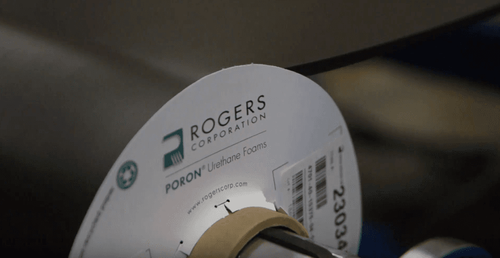
Selecting the Best PORON® Foam for Long-Term Compression Recovery
Die-cut PORON polyurethane foam is an excellent material for gasket design because it has an excellent compression set resistance, while also working well with pressure-sensitive adhesives.
PORON can compress to more than half its thickness without losing memory, which makes it a long-lasting, effective seal in many applications.
PORON polyurethane has a reputation for maintaining its compression set for the life of the product. When it comes to demanding applications, like battery pads, electronic enclosures and HVAC gaskets, PORON is a highly reliable option to guard your product against leaks and other causes of gasket failure.
Though a material like PORON has a sterling reputation for its compression set resistance, it’s critical to analyze the application to prevent gasket failure. Choosing the wrong foam density, hardness and thickness can lead to precisely that.
In the following, we’ll explain the compression set and how PORON polyurethane can help you minimize it.
What is compression set?
Compression set measures an elastomeric material’s ability to return to its original thickness after exposure to compression and high temperature for a specific amount of time.
Compression set — sometimes called permanent set — refers to the extent to which a material fails to return to its original thickness after being compressed for a specified time and temperature.
For further reading, check out our blog, Preventing Gasket Failure: Solutions for Compression Set in Die-Cut Gaskets.
Why does compression set matter?
When choosing the right material for gaskets, sealing and cushioning, factoring compression set is critical. But it’s also important to know how long the materials can stand up to squeeze. Will it require frequent replacement, or will it last for the life of the product?
In time, a loss of resiliency (or memory) can result in leaks or inability to absorb shock. The material’s long-term compression set resistance can be the difference between a successful product and a failed product.
When calculating compression set, you’re measuring resiliency – what percentage of thickness does it recover after compression?
Compression set is expressed as a percentage — from 0% (ideal recovery) to 100% (no recovery). Most elastomeric materials fall within a much narrower performance range, and lower percentages indicate better compression set resistance.
What causes compression set?
When the compression set of your elastomeric material is higher than expected, there may be underlying causes where the conditions exceed what the material can handle. For example:
- Temperature: Excessively high heat that leads to hardening and resiliency loss.
- Compression: Excessive squeezing (for example, over-tightening).
- Fluid: Material is incompatible with the fluids it’s exposed to.
While considering these, consulting with an experienced fabricator of elastomeric materials can help you avoid these issues.
What are the results of prolonged compression?
Compression of the elastomeric material creates a seal protecting components from dust, dirt, moisture as well as solvents and chemicals. While most elastomeric materials can achieve a low compression rating, compression set gives you an indication of the life of the seal.
To maintain a good seal, you need a material that resists or bounces back from prolonged compression.
However, prolonged compression can cause an elastomeric material to lose height. Compression creep — a loss of thickness under constant load and pressure over time — can contribute to long-term sealing issues.
It’s important to understand that compression creep is not always part of basic compression set testing, which is an important consideration in your gasket design.
Benefit of using PORON to achieve compression set resistance
PORON offers compression set resistance comparable to silicone. Its advantage? It excels in mechanical strength and cushioning for gasketing applications that don’t require extreme temperature or chemical resistance.
Choosing PORON: Density, thickness and hardness
Even though PORON is resistant to compression set, it’s still important to choose the appropriate density and hardness for your application. To guide you, PORON provides a Compression Force Deflection (CFD) Curve Tool that shows how the material performs in specific applications.
Adhesive-backed PORON solutions
SRP is proud to be one of 60 Preferred Converters for Rogers Corporation materials. Once you have your data and your selection of PORON materials narrowed, our technical experts can help you finalize your choice.
SRP is also a 3M™ Preferred Converter. When you’re looking for the best peel-and-stick pressure sensitive adhesive backing for your custom die-cut PORON gasket, our unmatched technical expertise will guide you to the best choice.
Send us your design and requirements through this online form or calling us at 847-593-5630. We’ll deliver a fast accurate quote within one business day.
